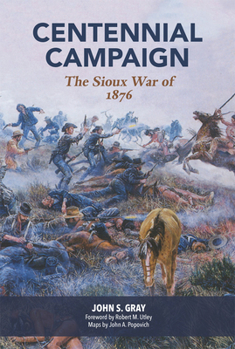Centennial Campaign: The Sioux War of 1876
Select Format
Select Condition 
Book Overview
"A fine book...In the twenty-two chapters that comprise the background and the campaign narrative, the author is at his best when he moves away from the Washington scene to detail the field operations. But it is the second part of the book-seven chapters labeled "Facets"-that moves Centennial Campaign into the realm of the exceptional. Here Dr. Gray combines impressive research, careful analysis, and sound deduction to reconstruct Indian movements,...
Format:Paperback
Language:English
ISBN:0806121521
ISBN13:9780806121529
Release Date:June 1988
Publisher:University of Oklahoma Press
Length:412 Pages
Weight:1.36 lbs.
Dimensions:1.2" x 5.9" x 9.0"
Customer Reviews
5 ratings
Remarkable!
Published by Thriftbooks.com User , 16 years ago
This is possibly the finest single volume history of the Sioux War of 1876. I never realized from the Army's position what a concentrated effort, involving thousands of soldiers, this was. I also never realized that the Sioux inflicted not one but two significant defeats on the Army, both by 2 different groups of Indians and each within just a few days of the other. From the Army point of view this was a determined campaign, involving 3 separate, converging columns over thousands of square miles. From the Indian point of view this was an uncoordinated, chance thing, with 2 different groups rendezvousing with each other within just a few days. This is an excellent work about a strange pseudo war whose centerpiece is the Custer massacre. John S. Gray provides a meticulously researched, somewhat controversial, account of what appears to have been a totally unnecessary war. The maps are very well done, allowing a greater understanding of the tactical issues and terrain faced by both sides.
the best
Published by Thriftbooks.com User , 17 years ago
This is the best book on this subject! You should also get his book on the last stand.
A Total Picture of The Sioux War: Before and After Custer
Published by Thriftbooks.com User , 23 years ago
This is a great book to learn everything about the 1876 Sioux War from the political and economic situations that fueled the conflict (gold and the Black Hills, dissolving the 1868 Peace Treaty), the behavior of the independent Sioux, Grant's ultimatum, the Sheridan three prong attack on the Sioux, the political (Custer and Grant) and weather problems hindering he start of the campaign and General's Crook and Terry's frustrating attempts to catch the Sioux and Cheyenne who fragmented into smaller groups after the Little Big Horn. Also covers Crook's March campaign that resulted in a controversial but failed battle on the Powder River and the critical battle of the Rosebud in June 30 miles southeast of the Little Big Horn which occurred just 8 days prior to Custer's annihilation. Crook, the great Indian fighter with twice Custer's number, becomes displaced out of the Sheridan attack plan due to the furious attack by the Sioux and Cheyenne. Gray also documents how the winter roamers left the agencies to join the summer roamers (Sitting Bull, Gall, Crazy Horse, Two Moon) which peaked with one of the largest villages ever on the North American continent at the time of Custer's attack. The book completes the story by detailing the aftermath of Custer's battle with Crooks and Terry's joint and separate campaigns and the addition of General Nelson Miles. Not a total story on Custer, for that you should read Gray's "Custer's Last Campaign" but start with "Centennial Campaign" to get the complete picture.
The Best about the Sioux War
Published by Thriftbooks.com User , 23 years ago
In 1981 I made a phone call to a retired medical doctor named John Gray. I told him I had just finished reading his book, CENTENNIAL CAMPAIGN, and would love to talk with him. I figured we would talk on the phone, so I was surprised when he invited me to visit him in his home in Ft. Collins, Colorado. I accepted his invitation without hesitation.We spent the entire afternoon talking about his book. There was one question that I was anxious to get answered. Why did he write less than a page about the Custer fight itself? Gray didn't really know what happened during that battle, so there really wasn't much to say. I laughed but it made sense. This book is not about the Custer fight, but about the entire campaign of the Sioux War of 1876 and it is filled with new revelations about the causes and events of this war. Most interesting is Gray's narrative about the White House meeting between Grant and his aides concerning how they should deal with the Sioux problem and why they started a war.The book is filled with detailed maps of the Indian movements during the campaign, where and when they camped and for how long. The same is done for soldier column movements. There is an excellent analysis of the size of the warrior force at the Little Bighorn that historians accept to this day. The numbers will surprise you.If you have not read much on the Sioux war, then I highly recommend this book. You'll learn that the Custer fight was just one of many events of a long brutal, bloody war.
The finest book on the Custer battle
Published by Thriftbooks.com User , 24 years ago
With an unromantic and realistic attitude John S. Gray has given us the finest book ever on the battle of the Little Big Horn. Furthermore, he has given us the buildup and aftermath of Custer's famous last stand, and thus given us a truly believable account of this, the most famous of Indian wars. If You're into Custer, Indians or the western frontier, You're not excused from not buying this book. It stands as perhaps the finest work in the entire Custer/Little Big Horn library.




